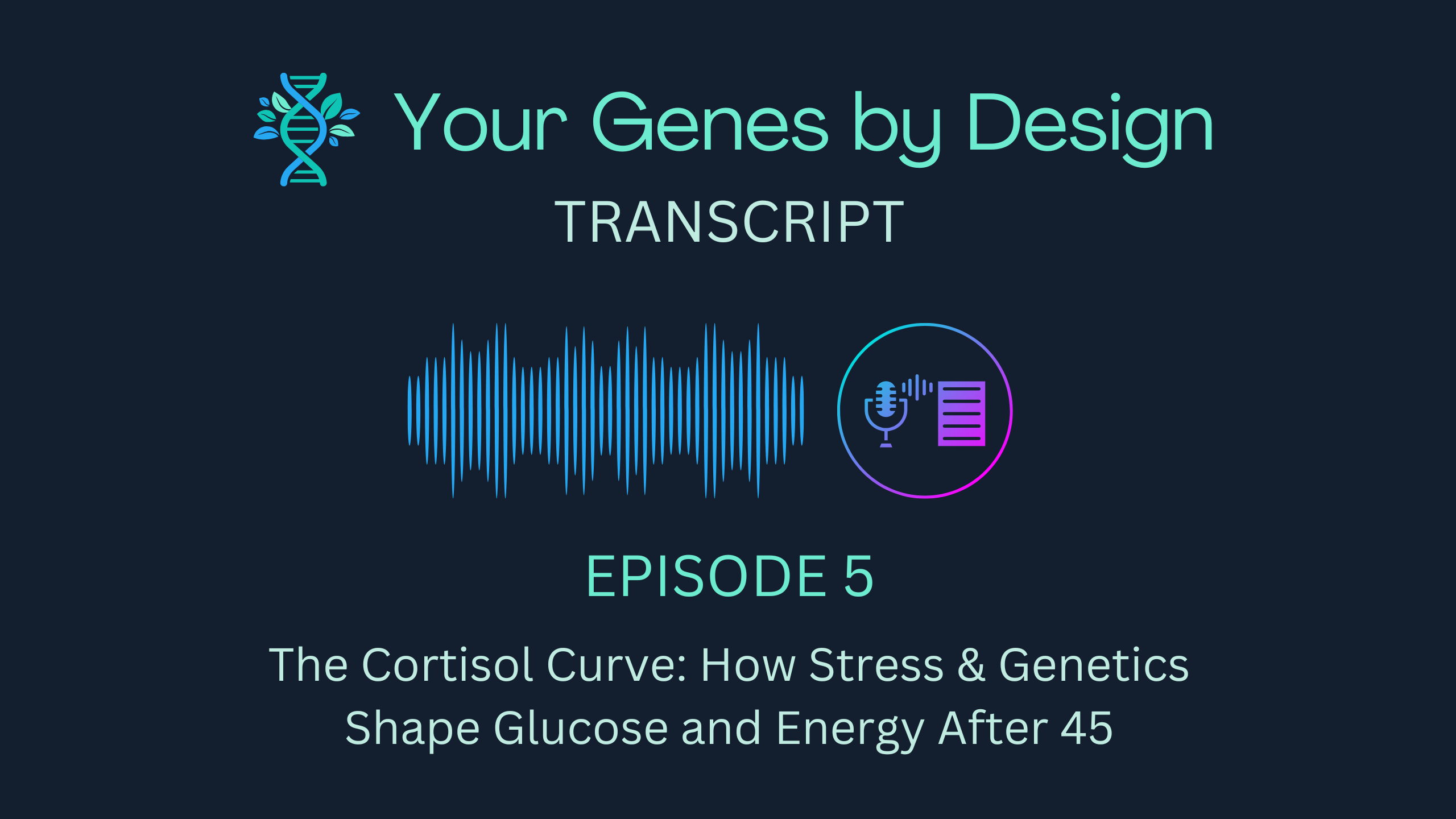
0:00 Intro Music + Voiceover
Your Genes by Design Podcast with Lauri Wakefield
0:31 Welcome and Series Context
Hi, I’m Lauri. Thanks so much for joining me today on the Your Genes by Design Podcast. This is the fifth episode in the Glucose and Insulin by Design series. In the last episode, we talked about metabolic flexibility, which is how your body switches between glucose and fat for fuel. Today we’re shifting to the hormone that coordinates that whole process behind the scenes—cortisol. Cortisol is often called a stress hormone, but it’s really your body’s rhythm regulator. It shapes how you wake up, how you focus, and how your body decides when to release or store fuel. When this rhythm is steady, you can handle stress and still have energy left for everything else in your life. When it’s off, you can feel wired and tired and alert but drained all at the same time, and then your glucose balance starts to follow that same uneven pattern.
1:11 Meet Cortisol — The Rhythm Setter
Think of cortisol as your internal day starter. Every morning your body naturally releases a surge that tells your liver to send glucose into your bloodstream so your muscles and brain have fuel. By midday, cortisol should begin to fall, letting insulin guide glucose smoothly into your cells for steady energy. But when stress becomes constant from deadlines, lack of sleep, or ongoing worry, that curve flattens, and cortisol either stays too high for too long or drops too low too soon. The result is that glucose gets mismanaged. You may notice mid-afternoon crashes, sugar cravings, or restless energy at bedtime. It’s not just emotional stress; it’s metabolic stress showing up in real time.
2:45 Why Midlife Changes the Equation
Let’s look at why this matters after the age of forty-five. Estrogen and progesterone naturally decline in your mid-40s, and those two hormones normally buffer cortisol’s effects. Without that balance, cortisol spikes hit harder and linger longer. Sleep quality changes, recovery slows, and blood sugar can swing more easily. You might find that the same workload or daily routines feel more draining than they used to. That doesn’t mean you’re doing anything wrong. It means your body’s stress chemistry is responding differently and needs a new rhythm to match this stage of life.
3:22 Genes That Shape Cortisol Recovery
Now let’s look at how your genes shape your personal cortisol rhythm. COMT helps clear stress hormones like dopamine and norepinephrine once a challenge is passed. If you have a slow COMT variant, those chemicals stick around longer, keeping your system in go mode even after the stressor is gone. If you have a faster variant, you may burn through them quickly and feel depleted sooner. IL6 is an inflammation-signaling gene. When it’s more active, your body can stay in repair mode longer after stress, leaving you feeling drained, achy, or not fully restored. SOD2 protects your mitochondria from the oxidative stress created by cortisol spikes. When SOD2 activity is lower, recovery takes more nutritional support, so vitamin C, manganese, and antioxidant-rich foods can make a difference. Another gene we’ve looked at in other episodes is PPARGC1A, which supports mitochondrial efficiency or how well your body turns glucose into usable energy. When it’s strong, even light movement helps burn the glucose released during stress instead of storing it. Together these genes explain why one person can bounce back quickly after stress while another feels drained for days. They don’t determine your fate; they describe how your system prefers to recover.
4:51 Everyday Patterns as Useful Signals
There are some ways you might notice your cortisol rhythm in everyday patterns. You wake up feeling groggy and tired but feel alert late at night. You crave sugar mid-afternoon or after emotional stress. You feel anxious when you skip meals. It takes longer for you to unwind even when you’re tired. Each pattern is a signal from your biology, not something you’re imagining.
5:17 Precision Tips Matched to Variants
Your genes outline how your body manages the daily stress-to-recovery cycle. If you have a slower COMT variant, try to build short pauses or rest time into your day such as a walk, a breathing break, or a mindful transition between tasks. This can help your chemistry reset. If you have a higher IL6 variant, focus on steady meals with omega-3s and anti-inflammatory foods and balance intense workouts with restorative ones. If you have a lower SOD2 variant, eat more colorful produce, take magnesium, and get good sleep to offset oxidative stress. If you have a strong PPARGC1A variant, keep your body moving; even light activity turns cortisol’s fuel release into clean, steady energy. Precision isn’t about fixing yourself; it’s about understanding your design so you can work with it instead of pushing against it.
6:36 Reframing Cortisol as Feedback and Closing
Cortisol isn’t the enemy; it’s feedback. It tells your body whether you feel safe, nourished, and supported. Your genes and your daily habits fine-tune how long that message lasts. When you align with your natural cortisol rhythm, you regain more than energy—you regain trust in your body’s timing. You’ll notice steadier mornings, calmer evenings, and a sense that your energy is finally becoming more lasting and stable. If you don’t know what gene variants you have or how you can find out, I’ll be publishing a series of three or four articles in my Your Genes by Design newsletter on Substack that explains all of this. I’ll link to it in the show notes. If this episode helps you understand why stress feels different after 45, follow the Your Genes by Design Podcast for more short, science-based insights made practical for real life. And if you found it helpful, please share it with another woman who might benefit. That’s going to wrap things up for this episode. Thanks again for joining me and have a great day.
